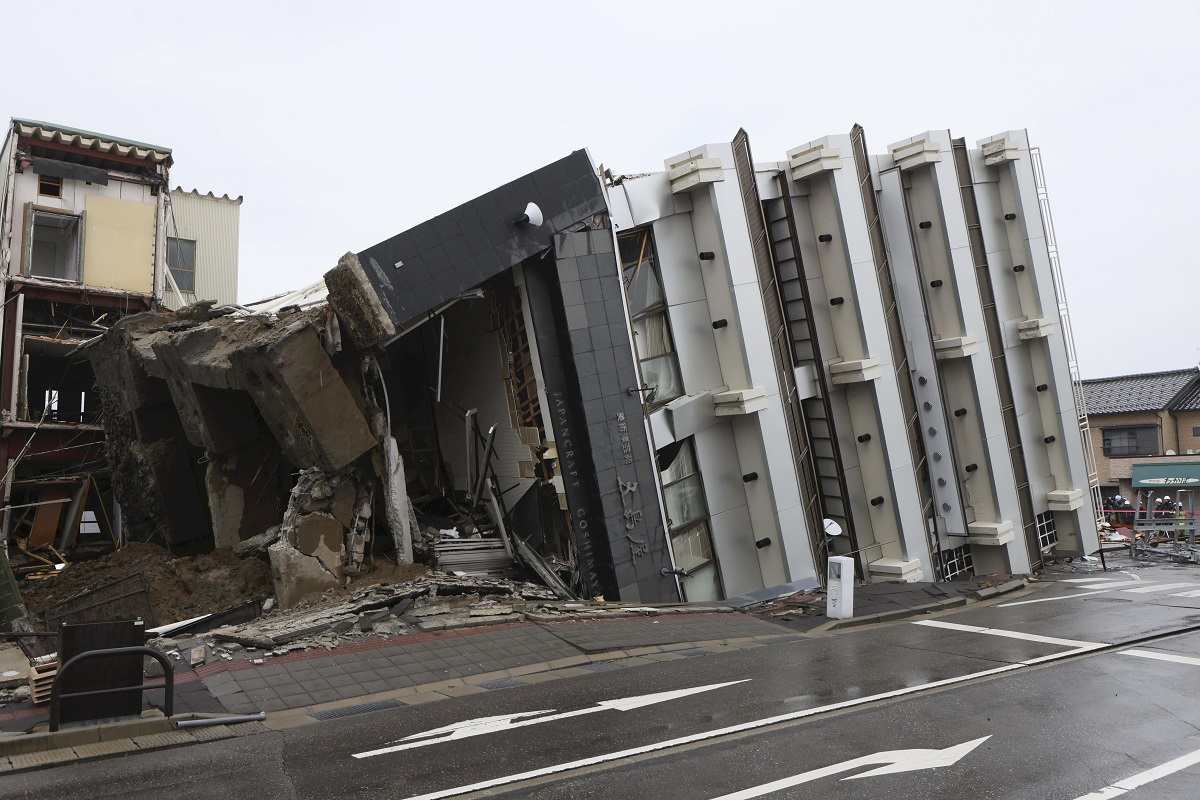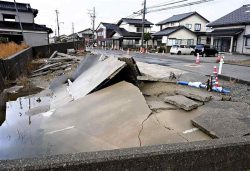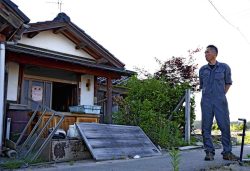Collapsed Building in Wajima Suffered Damage to Footings; Underground Structures of Other Buildings in Area Likely Damaged

A seven-story building that collapsed due to the Noto Peninsula Earthquake is seen in Wajima, Ishikawa Prefecture, on Jan. 3.
13:06 JST, January 13, 2024
WAJIMA, Ishikawa — Despite being designed to have a high earthquake resistance, a seven-story reinforced concrete (RC) building in Wajima, Ishikawa Prefecture, toppled over due to the Noto Peninsula Earthquake, which registered the maximum 7 on the Japanese seismic intensity scale. I recently joined Prof. Koichi Kusunoki, an expert in earthquake engineering at the Earthquake Research Institute of the University of Tokyo, at his on-site survey in the affected area.
In the Kawaimachi district of Wajima, the base of a building that was more than 20 meters high crumbled and smashed into the three-story building on its east side that housed a restaurant and residence. The collision reduced the height of the three-story building so much that I — at 1.84 meters — was now taller than it.

According to the website of the company that owns the taller building, it was constructed in 1972 and had seven stories above ground and one story below. As we went to see the west side of the building, the underside of the foundations, known as the footings, along with four or five round holes, were visible. Normally, piles are inserted into these holes and extend down to the solid bedrock to support the outer walls of the building. The footings had seemingly come free of the piles.
Kusunoki said it was the first time he had seen such damage from an earthquake in Japan since the Great Hanshin Earthquake in 1995. He acknowledged that the reason for the collapse had “yet to be determined at this stage,” but he believes that the building was shaken so violently in all directions that the piles on the west side came loose from the foundations, causing the building to tilt eastwards. The underground structure on the east side was also damaged, resulting in the collapse.
Five other RC buildings in the central area of the city, ranging from 3 to 7 stories and generally at least 50 years old, were found to have been tilted between 0.4 and 4 degrees. A tilt of 4 degrees results in a change in height of about 7 centimeters per meter, which may cause issues like dizziness and nausea. The exterior of these buildings, including the columns and walls, showed no significant visible damage.
“It is highly likely that their underground piles have been destroyed,” Kusunoki said.
The area where these buildings stand is close to the sea and a river, and there were signs of liquefaction.
“Soft ground may be one of the reasons that so many RC buildings were damaged [by the quake],” Kusunoki said.
"Society" POPULAR ARTICLE
-

M4.9 Earthquake Hits Tokyo, Neighboring Prefectures
-

M7.5 Earthquake Hits Northern Japan; Tsunami Waves Observed in Hokkaido, Aomori and Iwate Prefectures
-

Israeli Tourists Refused Accommodation at Hotel in Japan’s Nagano Pref., Prompting Protest by Israeli Embassy and Probe by Prefecture
-

Tsukiji Market Urges Tourists to Avoid Visiting in Year-End
-

M5.7 Earthquake Hits Japan’s Kumamoto Pref., Measuring Upper 5 Intensity, No Tsunami Expected
JN ACCESS RANKING
-

Keidanren Chairman Yoshinobu Tsutsui Visits Kashiwazaki-Kariwa Nuclear Power Plant; Inspects New Emergency Safety System
-

Imports of Rare Earths from China Facing Delays, May Be Caused by Deterioration of Japan-China Relations
-

University of Tokyo Professor Discusses Japanese Economic Security in Interview Ahead of Forum
-

Japan Pulls out of Vietnam Nuclear Project, Complicating Hanoi’s Power Plans
-

Govt Aims to Expand NISA Program Lineup, Abolish Age Restriction





















